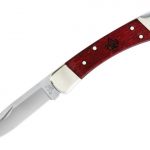
Few things peeve me more than dull knives.
As someone who spends a lot of time breaking down game animals and cooking them, having the right tools to complete the job is critical; my food is already dead, and the last thing I want to do is fight with it again in the kitchen.
So over the last few years, I’ve put together a collection of knives that I enjoy using most: knives that will take me from field to table.
In the Field
For dressing out and quartering animals in the field or in your garage, the two knives I use are the Havalon Piranta Edgeand my husband’s trusty 110 Folding Hunter Buck knife, which his father gave to him.

The Buck knife is hardwearing and will last a lifetime if you take care of it. Stiff and robust, the blade is tough enough to cut through hide, cartilage and joints.

For more precise work, such as caping/skinning, deboning and carving out muscle groups, the Havalon Piranta has been my go-to for many years. Its replaceable, surgical blade cuts through meat like butter. When deer is hanging, you let gravity do most of the work with this little knife. And its thin, fine blade also makes easy work of breaking down smaller game animals such as quail, partridge, small ducks, squirrels and rabbits. Havalon knives come with a package of replacement blades, allowing you to work with a fresh blade every time.
Moderately priced, both knives retail under $50.
For the Freezer
For cutting down muscle groups into smaller pieces, such as steaks and roasts, I suggest investing in a quality boning knife. I have the Shun Classic 6-inch boning/fillet knife ($144), which is not only beautiful but also highly functional.

With a little bit of practice, its long, extremely sharp edge allows me to precisely cut meat – both raw and cooked – into uniform portions. Its thin and semi-flexible point also makes efficient work of removing silver skin. I also recommend this Japanese knife for breaking down game birds.
In addition to game, it’s the best Thanksgiving turkey carving knife I’ve ever used.
Although Shun advertises this knife as a fillet knife as well, I do prefer something more flexible when skinning and deboning fish.
While I’m still using a cheap Rapala Fish ‘n Fillet knife ($29.99), which gets the job done when properly sharpened and is a good choice for throwing into your tackle box, it doesn’t hold its edge long. I have my sights on the Wüsthof Classic Ikon fillet knife ($202), which felt great in my hands at the store and comes with a leather sheath.

Also, every kitchen needs a pair of poultry shears for cutting off duck feet and bird butts. I don’t remember where I got mine or if they even have a brand, but they are sturdy and have worked fine all these years.
For the Table
In addition to my Shun Classic boning/fillet knife, my other workhouse in the kitchen is the Wüsthof Classic Ikon 7-inch hollow-edge santoku knife ($169).

I use this knife in 90 percent of my cooking: chopping, slicing, mincing and dicing. It has great balance and is made of strong German steel, while the Japanese-style blade offers fluid rocking motion for quickly chopping herbs. People with larger hands may prefer a classic chef’s knife, but as a vertically challenged woman with hands to match, I find better control in the santoku.
While I’ve upgraded to more expensive cutlery, I must not forget my humble beginnings: I purchased the J.A. Henckels International Fine Edge Pro 2-piece santoku set for under $25 at Target while I was in college.

These 7- and 5-inch knives have given me many years of service and still do in a more “retired” capacity, such as cutting through the occasional stubborn squash and accompanying me on camping trips. Although they do require more constant sharpening, as is expected of knives in their price range, it was the best $25 I’ve ever spent.
Knife Care
The more high-quality and sharper the knife, the harder the steel and ironically, the more prone it is to chipping or breaking. While a cheap knife from Walmart may not chip or break under abuse – that is because it’s made of a softer steel – the drawback is that it will not hold a keen edge.
- Take care of your investment by using these specialty knives only
as intended, handwashing them and drying immediately. - Store your expensive knives in a knife block or in their respective sheaths, not jumbling around in a drawer.
- Use them over quality wooden or plastic chopping boards, which will extend the life of your knives unlike hard glass or stone surfaces.
- Use a honing steel to keep your knives in tip-top shape throughout the year, and when needed, sharpen your knives with a good quality sharpener. Retailers such as Sur La Table and Williams-Sonoma also offer professional knife sharpening services for a fee.■
My Favorite Knives: For in the field and kitchen was originally published in the Jan/Feb 2018 print issue of NEBRASKAland Magazine.
The post Best Knives from Field to Table 2018 appeared first on NEBRASKALand Magazine.
















